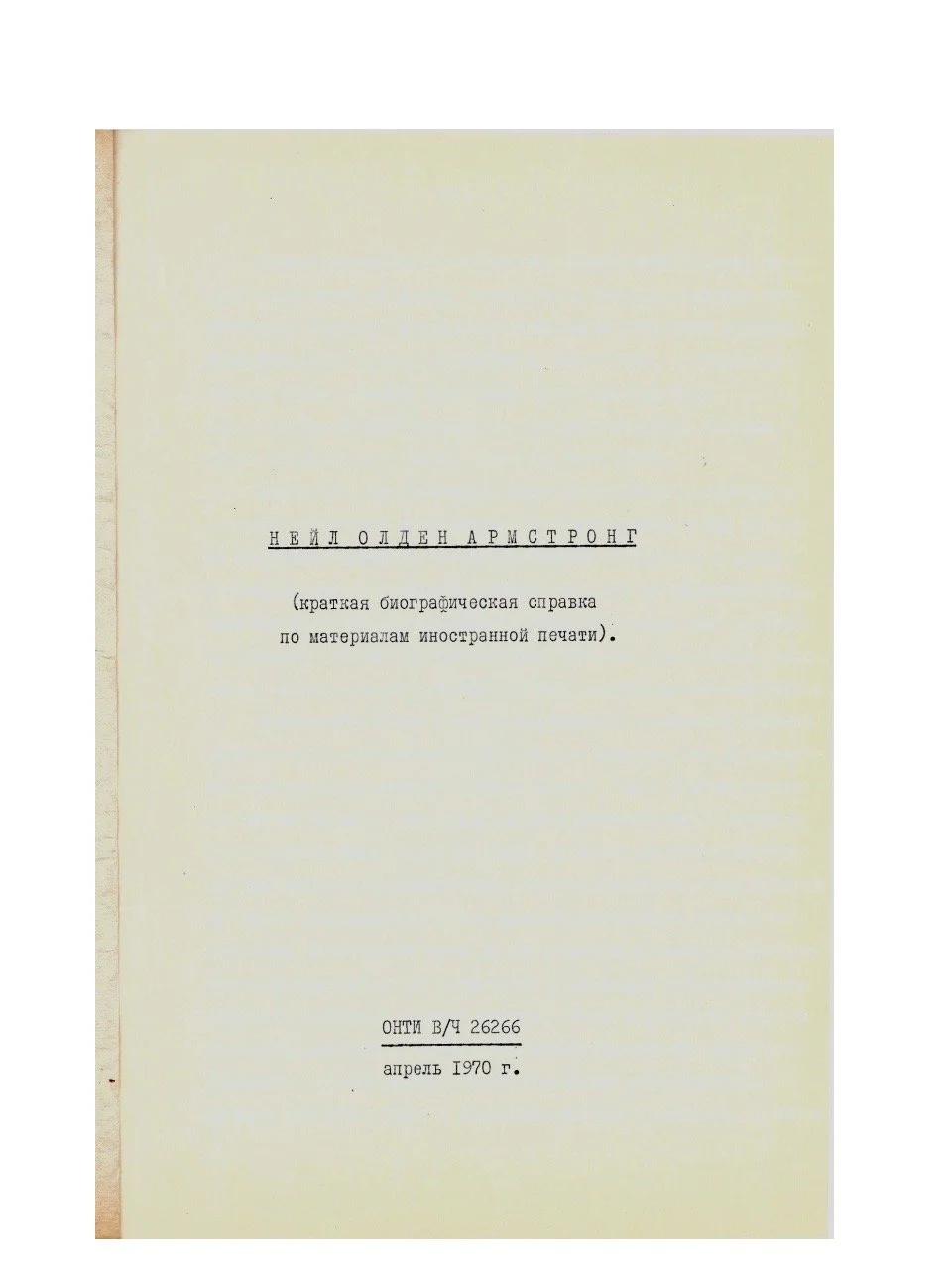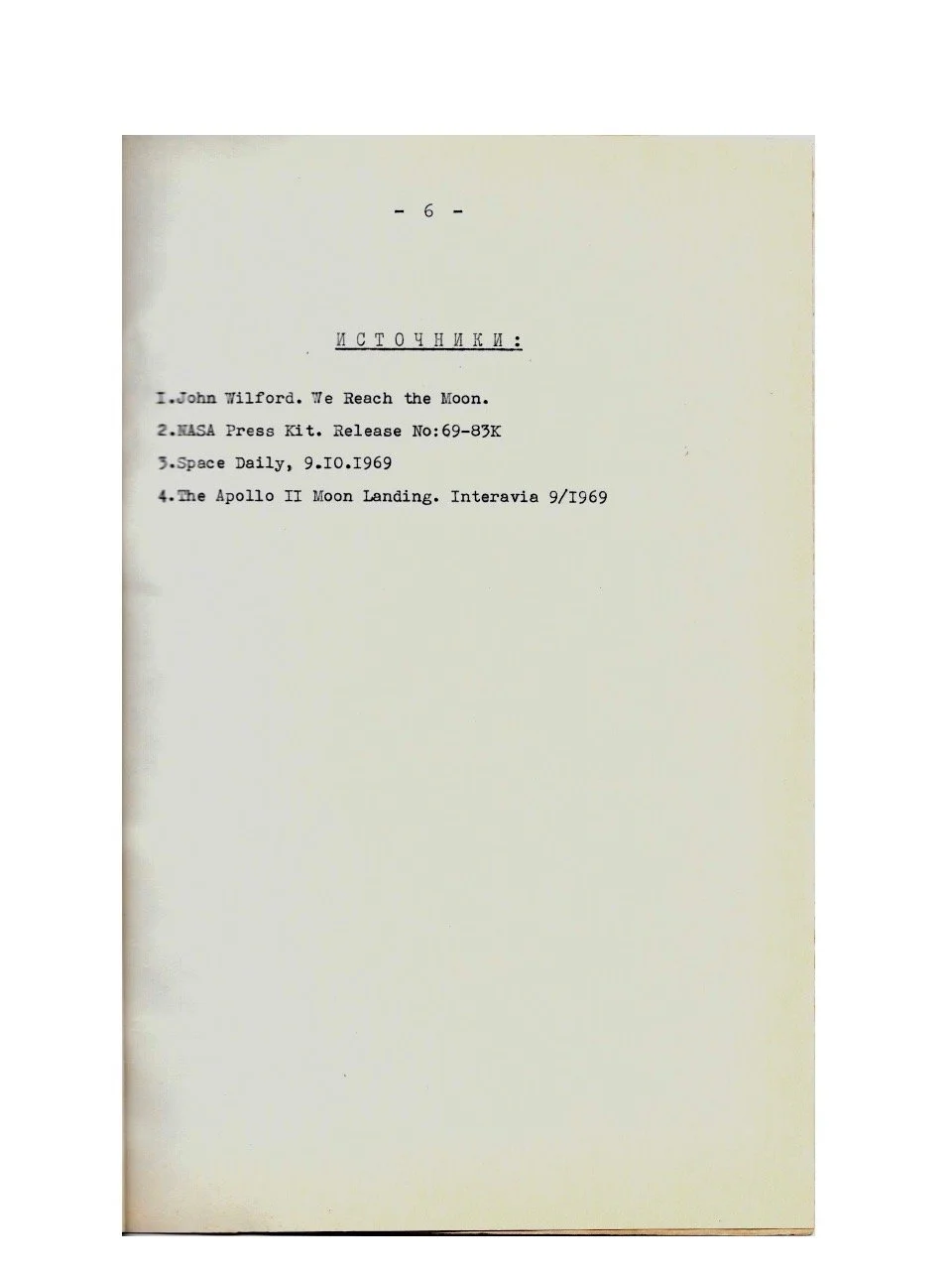Apollo 11 Neil Armstrong Dossier File in Cyrillic from the Archives of Soviet General Nikolai Kamanin










Apollo 11 Neil Armstrong Dossier File in Cyrillic from the Archives of Soviet General Nikolai Kamanin
Apollo 11 Neil Armstrong Dossier File in Cyrillic from the Archives of Soviet General Nikolai Kamanin
In May 1970, Armstrong traveled to the Soviet Union. He presented a talk at the 13th annual conference of the International Committee on Space Research. He met Premier Alexei Kosygin and was given a tour of the Yuri Gagarin Cosmonaut Training Center.
The file includes: Neil Armstrong Dossier File in Cyrillic signed by Researcher Major Okhrimovich. Nine reprints of photos taken during Neil Armstrong visit in USSR. Document signed by Commander of Military division 26266 General-Major of Aviation Pashkov.
Armstrong's visit to the USSR was ostensibly to present the full version of this paper at the COSPAR conference in Leningrad. He signed this copy for General Kamanin. Possibly unique as this is the only known copy of Armstrong Apollo 11 Moon landing signed report in Russian. In fine condition. Excerpt from Astronautics and Aeronautics, 1970. June 2 (p. 190): Apollo 11 Astronaut Neil A. Armstrong, on goodwill trip to U.S.S.R., watched TV broadcast of Soyuz IX launch during party in his honor in Moscow and was told by Cosmonaut Georgy Beregovoy that mission was "especially in honor of your trip here."Armstrong later presented moon fragment and small Soviet flag carried on Apollo 11 mission to Soviet Premier Aleksey N. Kosygin. Kosygin said he would "always cherish this gift as a symbol of a great achievement." He told Armstrong, "The Soviet peoples are second to none in admiring your courage and knowledge. "Soviet Academy of Sciences president Mstislav V. Keldysh called voyage "a big contribution to space exploration and further progress of world science." Cosmonauts send message to Apollo 11 crew: "We... closely followed your flight. We wholeheartedly congratulate you on the completion of your wonderful journey to the moon and safe return to earth."
Here is full translation of this Dossier File:
Neil Alden Armstrong (brief biographical information from foreign press material) military division 26266April 1970The first America astronaut to land on the moon and walk on the lunar surface, Apollo 11 crew commander Armstrong was born on August 5, 1930, in the city of Wapakoneta, Ohio State, to an employee's family.
Father Stephen Armstrong, financial auditor.
Mother Viola Armstrong, housewife. In the family, besides the eldest son Neil, there were two more children.
The area where the Armstrong’s family lived is populated mainly by immigrants from Germany, who emigrated to the United States during the reign of Bismarck, to avoid being drafted into the army, and mixed with the streams of participants in the war for independence.
Therefore, the most characteristic features of the inhabitants of this area, according to American authors, are diligence, honesty, religiosity and commitment to the Republican Party.
The upbringing of children in the Armstrong family was mainly handled by the mother, a well-read and musical woman.
Under her influence, Neil became addicted to reading and music.
Already in the first grade, he read 90 books. Due to good abilities and development, Neil moved to the third grade.
At school, he was fond of natural sciences and mathematics, successfully studied higher mathematics beyond the program and even replaced mathematics teacher when the teacher was sick.
In his free time, he played baritone in the school orchestra, learned to play the piano and was engaged in aircraft modeling.
He has been interested in aviation since early childhood. In order to earn money for the construction of models, and later to pay for aircraft navigation lessons, from the age of 7 he began to earn extra money in free time, first as a hay harvester and warehouse worker in a store, and then as a mechanic at the airport. Pilot's license received earlier, then driver’s license.
After graduating from high school in 1947, Armstrong entered Purdue University in Indiana.
From 1949 to 1952 he served in the US Navy Aviation. Participated in military operations in Korea where he made 78 flights from Essex aircraft carrier.
From 1952 we will continue our studies at Purdue University, from which we graduated in 1955 with a Bachelor of Science degree in aeronautical engineering.
After graduating from university, he joined NASA as a research pilot. At first, he worked at the Lewis Research Center, and then until 1962 at the NASA Flight Research Center at Edwardo Air Force Base in California, where he established himself as one of the best test pilots.
He flew experimental X-15 aircraft, X-1 rocket plane, paraglider, airplane F-100, F-101, F-102, F-104, F-5D, B-47 and other aircrafts. As a pilot of the V-29 carrier aircraft, he participated in the launch of more than 100 rocket planes. His total flight time is over 4000 hours in 1962, he applied for admission to the astronaut group, in September 1962 he became the first civilian astronaut of NASA. During the flight of the Gemini 5 spacecraft in August 1965, he was the commander of the backup crew.
On March 16, 1966, together with astronaut David Scott, he flew as the commander of the crew of the Gemini 8 spacecraft.
During this flight, the first successful docking of two spacecraft was carried out. The flight was aborted after 10 hours and 42 minutes due to an engine malfunction in the orientation and maneuvering system.
Armstrong took control and, thanks to endurance, self-control and high-flying skills, managed to make a safe landing.
During the flight of the Gemini 11 spacecraft in September 1966, he was the commander of the backup crew.
On July 16-24, 1969, as the crew commander of the Apollo 11 spacecraft, together with the pilot of the main unit Michael Collins and the lunar cabin pilot Edwin Aldrin, he flew to the moon with a landing in the Sea of Tranquility and access to the lunar surface. Flight duration - 195 hours 18 minutes, stay on the Moon - 21 hours 37 minutes, trip to the lunar surface - 2 hours 13 minutes.
Prior to the flight on the Apollo 11 spacecraft, he was a corresponding member of the Society of Experimental Aircraft Test Pilots, a corresponding member of the American Institute of Aeronautics and Astronautics, and a member of the American Gliding Society.
One of Armstrong’s hobbies is gliding, for achievements in which he was awarded a golden pin.
In 1962, he received the Octave Chanute Prize, established by the Institute of Aerospace Sciences, and the John Montgomery Prize, in 1966, the American Institute of Aeronautics and Astronautics Prize. Awarded the NASA Distinguished Service Medal. After the flight on the Apollo 11 spacecraft, he was awarded, along with the rest of the crew, the highest civilian government award of the United States, the Medal of Freedom, as well as the Hubbard Medal established by the National Geographic Society.
By nature, he is friendly, modest, reserved, thoughtful and somewhat shy. Enjoys the respect of close friends and work colleagues. Dedicated to his work, proud of his profession, which he considers the main business of his life. Cold-blooded, enduring, patient. He skillfully hides his philosophical and religious views and beliefs even from his closest relatives.
He has business ingenuity, successfully participated in stock market.
Married. Wife Janet Armstrong (maiden name Chiron)
Children: son Eric, born in 1957
Son Mark, born in 1963
Daughter Karen died of a brain tumor.
Good family man. He loves solitude with his family. In addition to gliding, he enjoys music and fishing.
He doesn’t smoke. Drinks moderately. Lives in a suburb of Houston, not far from the center of manned spacecraft.
The annual salary in 1969 was $30,054.
Researcher Major Okhrimovich (signature) April 15, 1970.
TRANSLATION OF DOCUMENT:
Military Unit DEPUTY COMMANDER-IN-CHIEF VVS
26266 GENERAL-MAIJOR OF AVIATION
August 21, 1970 COMRADE GOREGLAD L.I.
No. 537 MOSCOW, K-160, military unit 64190
I present the translation of the scientific results of the flight and observation of the Apollo 11 spacecraft eco-page from NASA's preliminary scientific report, performed by the ONTI (Association of scientific and technical publishing houses) of the headquarters of military unit 26266.
Application
Translation, 29 pages,
unclassified, only to the addressee
Deputy commander of military unit 26266
General Major of Aviation Pashkov (signature)
Some information:
Cosmonaut Training Center (military unit 26266)
Leonid Ivanovich Goreglyad - Soviet fighter pilot, WWII participant, Hero of the Soviet Union (02/23/1948). Air Major General
Since January 1961 - Inspector General for Space - Assistant to the Commander-in-Chief of the Air Force for the preparation and support of space flights. Participated in the creation and training of the first detachment of Soviet cosmonauts, and then in the preparation and conduct of manned space flights. In April 1976, Major General of Aviation L. I. Goreglyad was transferred to the reserve.